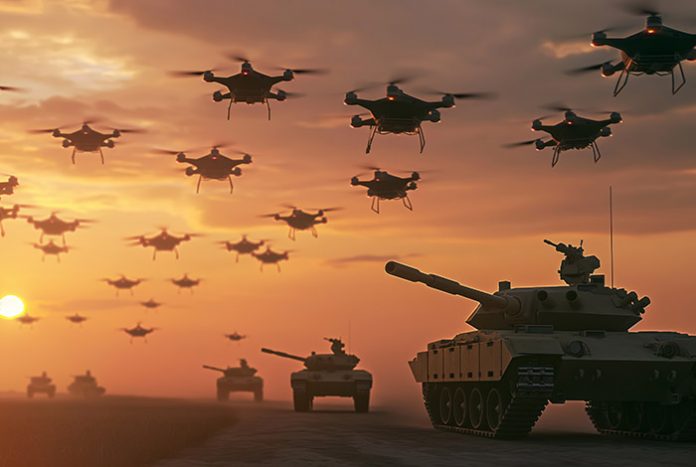“The seize-and-hold tactics that Russia has had forced upon it by her failure to topple the Ukrainian regime in the first weeks of the invasion are not conducive to either side achieving a swift military resolution of the conflict. The meat grinder is alive and well. And it is very militarily unattractive. Especially if your orthodoxy speaks of a small, agile, dispersed, modern mongoose of a military model.” – Major General (retd) Dr Andrew Sharpe questions if the British Army is being a little narrow-minded when it comes to considering the likely character of the future combat environment.
Read the digital document above, download a copy here or continuing reading below.
I wonder if we are being a little narrow-minded; or, if I were being cruel, I might even say being a little dense, when we consider the likely character of the future combat environment? Perhaps, because of the constraints of money, time, resource, ambition, et al, we have to be. The notion of a ‘less dense battlespace’ has become a fairly widely accepted way of describing the context in which our future soldiers will find themselves in the event of major war.
Of course, we know that not everything in this environment will be ‘less dense’ – for a start, one of the main reasons that we keep hearing our ground forces will need to be dispersed, and our HQs small, agile and more-or-less constantly on the move, is that the near-to-ground airspace above them is going to be much, much more densely populated than it ever has been before. The ubiquity of the cheap but highly effective drone in Ukraine, on both sides of the front line, is a lesson that only a force development fool would ignore. For this, and for many other similar reasons, the less dense battlespace orthodoxy has gained considerable (and valuable) traction as we think forward to our likely future combat environment. On this basis we focus our (necessarily limited) experimentation resources on the likely scenarios that these circumstances suggest. We make our best guess at the character of the space in which we are likely to find ourselves and to have to fight.
At the same time, those same constraints of money, time, resource, ambition, et al, have also driven us (in the UK, at least, but also in our allied camps) to be considering a smaller, more self-sufficient, more potent but less concentrated, agile-of-mind-and-form Army. This future Army’s combat formations, we are told, will be ‘battle winning’, and will (must) be capable of winning the ‘first fight’. We will structure, poise, be ready, and deploy ahead of the danger of latent threats developing into patent hostile actions, such that the enemy will have to fight on our terms. And we have made it (publicly) clear that this is our intent, and that we will configure our capabilities accordingly.
We have also made it clear, in our active professional debate, that the triple-lined, Soviet-style, drone-and-artillery-supported, dragon-toothed, mined, layered, established defensive lines of the Ukrainian front are really tough nuts to crack. The seize-and-hold tactics that Russia has had forced upon it by her failure to topple the Ukrainian regime in the first weeks of the invasion are not conducive to either side achieving a swift military resolution of the conflict. The meat grinder is alive and well. And it is very militarily unattractive. Especially if your orthodoxy speaks of a small, agile, dispersed, modern mongoose of a military model. And, because this is so, we tell ourselves that we will ‘ensure’ that we will not allow ourselves to get embroiled in such a fight. It’s only six letters, but ‘ensure’ is a very, very big word. No doubt the authors of the Schlieffen Plan assured the Kaiser that it would ‘ensure’ the swift capitulation of France (without the advent of four years of trench warfare). No doubt those who deployed the British Expeditionary Force were confident that they, alongside their French allies, would ‘ensure’ that the German plans were foiled and that they would all be home for victory parades by Christmas time. No doubt the conceptual developers and force developers assured the hierarchy of the Third Reich that the Blitzkrieg capability would, on one front after the other, bring about the swift defeat of Germany’s enemies, and ‘ensure’ that there was no second defeat of Germany after more years of grinding war.
Of course, Russia, and others, are watching us as we hold this debate and make these assurances about our desire to shape the operational context. And they are doing their own force development and strategic, operational and combat estimates. Like us (because they are not daft), they will seek to find the courses of action that suit their opponents least. The more we tell them that we don’t want to fight a toe-to-toe slog, supported by massed artillery (which we don’t have), supplied by a buoyant shell-making defence industry (which we don’t have), overwatched by massed drones (which we don’t have), the more they are going to try to ‘ensure’ that that is exactly what we have to do. Thus, as both sides try to ‘ensure’ that circumstances deliver a context of the future fight that suits them best and their opponents least, the wise force developer and planner would make it a 50/50 bet.
I suggest, therefore, that we should not just be generating the scenarios for experimentation and force development that we have to, within all those aforementioned constraints; and that we should not just be developing the doctrine and tactics to fight our chosen fight with our chosen force. To do only that, would be to hope that every time that we roll the future-fight dice we get the 4, 5 or 6 that we need. Of course, we may not, realistically, be able to afford to have, standing ready, the forces that we might need to have to be able to fight the fight that may be required of us if we shake a strategic 1, 2 or 3; but we would, surely, be wise to understand for ourselves, and explain to our political leadership, what we may well need under such (perfectly realistic, regardless of how undesirable) circumstances.
If we find ourselves having to break through that triple-layered Russian defensive line (whether in the Donbas, or Estonia, or Poland, or anywhere else for that matter) because they have done their estimate and their risk/cost/gain analysis better than us this time, what will we need? Or, because the Clausewitzean laws of chance in war mean that the operational context turns out that way despite our best efforts, what will we need? What if the only way that we can fight our chosen fight, in a less dense battlespace, is, first, to have to break through a more dense battlespace? And we don’t have to make up or imagine the scenarios to experiment against, in this respect, because we have a live case study, every tiny detail of which is available to us, to experiment against.
What artillery would we need (compared to what we have got and are planning to get) to compete in this battlespace? What combat engineering capability (compared to what we have got and what we are planning to get) would we need? What unit-level drone capability would we need (we have none)? What integral low-level anti-drone-capable unit and formation air defence capability would we need (we have almost none)? What combat arm mass would we need (we have little)? Etc, etc. And, beyond the force development of our Army, what capacity will we ask of our Defence industry? And what combat casualty tolerance will we ask of our polity and our politicians?
To be clear, I am not advocating that we should wish, ever, to get involved in such a fight. But we would do well to make sure that, in this real, extant and highly possible scenario, despite our best intentions and doctrinal developmental aspirations, we understand what it will ask of us. And that we explain it to all who need to understand it (ourselves included!). I really hope that we won’t be called upon to fight such a fight. But hope is not a strategy.





